|
Seeing Gertrude Stein: Five Stories
May 12 - Sept 6, 2011 Contemporary Jewish Museum (SF)
Oct 14, 2011 - Jan 22, 2012 National Portrait Gallery, Smithsonian (DC)
The Steins Collect: Matisse, Picasso, and the Parisian Avant-Garde
May 21 - Sept 06, 2011 San Francisco Museum of Modern Art (SFMOMA)
Oct 5 2011 –Jan 16 2012 Grand Palais, Galeries Nationales (Paris)
Feb 21 - Jun 3, 2012 Metropolitan Museum of Art (NYC)
Stanford University Professor Emeritus Wanda Corn started talking about Seeing Gertrude Stein over ten years ago. By the S. R. Poet's standards, Dr. Corn is connected directly or indirectly to a good deal of the 2011 Stein activities. In 2007, Professor Corn spoke with the S.R. Poet about the exhibition Seeing Gertrude Stein and said she hoped her exhibition, along with many other events, would take place in 2010. While The Steins Collect exhibition came about independently from Corn's exhibition, her partners and she agreed it would be best to open Seeing Gertrude Stein in close timing with The Steins Collect. Corn's idea was always to create a closely timed groundswell of activities focused on Stein.
A COMPENDIUM OF STEINIAN EVENTS IN 2011
In 2011, San Francisco kicked off two major art exhibitions associated with Gertrude Stein. Seeing Gertrude Stein: Five Stories was co-curated by lead guest curator Professor Wanda M. Corn of Stanford University and associate curator Professor Tirza True Latimer of the California College of Arts. The Steins Collect: Matisse, Picasso, and the Parisian Avant-Garde was co-curated by four museum representatives: Janet Bishop, curator of painting and sculpture at SFMOMA; Cécile Debray, curator of historical collections at the Musée national d'Art moderne, Centre Pompidou, Paris; Rebecca Rabinow, associate curator and administrator, Department of Nineteenth-Century, Modern, and Contemporary Art at the Metropolitan Museum of Art; and Gary Tinterow, Engelhard Chairman, Department of Nineteenth-Century, Modern, and Contemporary Art at the Metropolitan Museum of Art.
While Sony Pictures Classics made a nationwide May release of Woody Allen's Midnight in Paris with an appearance of Gertrude Stein portrayed by Kathy Bates, in San Francisco, other Stein-centered events brought attention to the two Stein art exhibitions. At the Yerba Buena Center for the Arts August 18-21, SFMOMA produced Gertrude Stein's and Virgil Thomson's opera Four Saints in Three Acts by Ensemble Parallèle. In June, co-curators Corn and Latimer, along with others including Scene4's Renate Stendhal gave a five-session course on Seeing Gertrude Stein in the University of California Berkeley Extension program. In August, Steven Watson gave a talk from his book Prepare for Saints: Gertrude Stein, Virgil Thomson, and the Mainstreaming of American Modernism.
In Washington, DC, along with the arrival of the Seeing Gertrude Stein exhibit came the opening of Insight & Identity: Contemporary Artists and Gertrude Stein at the Stanford in Washington Art Gallery. Also a co-partnering with the 2nd annual Feminist Art History Conference brought curator-led tours through the Seeing Gertrude Stein exhibit and panel talks and papers on the exhibit and Stein herself.
In Paris, along with the opening of The Steins Collect exhibition, visitors were encouraged to attend lectures by prominent Steinistas like Marjorie Perloff, Joan Retallack, and Charles Bernstein on the literary portraits written by Gertrude Stein, the importance of the relationship she had with Alice B. Toklas, the friendship she had with Pablo Picasso, Stein as avant-garde-ist, and bi-lingual recitations of her work. In November, Dartmouth professor Barbara Will presented her first public reading of Unlikely Collaboration: Gertrude Stein, Bernard Fay, and the Vichy Dilemma. The book released in September is creating quite a stir about Stein's World War II activities that included her bad translations of speeches by the head of the Vichy government.
Stein-centered events this year not connected to the two art shows include such programs as "Gertrude Stein II: "Meditation meditation": A Joint Talk" in honor of the October 2011 re-issue of Stein's Stanzas in Meditation, forthcoming from Yale University Press (the scholarly panel discussion took place at the Pacific Ancient and Modern Language Association conference, November 5-6, 2011, in Claremont, California) and Gertrude Stein Gertrude Stein, a staged radio drama and monologue by Jane Hardy that took place November 11-12 at The Raconteur in Metuchen, NJ. The reality check is that over the decades since this Modernist's death in 1946, there are always events inspired by the work and life of Gertrude Stein though not at the level of publicity that this year had brought.
WHY SEEING GERTRUDE STEIN ANCHORS THE YEAR OF STEIN
By combining high and low artwork with "material culture"—things one might never imagine for inclusion in an art exhibition (e.g. wallpaper, articles of clothing, snapshots), Wanda Corn and Tirza Latimer have created with their exhibition Seeing Gertrude Stein a holistic look at Gertrude Stein, the self-proclaimed genius, experimental Modernist writer, art collector, American ex-patriot, secular Jew, lesbian partner of Alice B. Toklas… At the Contemporary Jewish Museum opening of this exhibition, Corn said while acknowledging the many contradictions of Gertrude Stein, she hoped to create a human scale for Stein, warts and all. In a Cubist approach, the co-curators organized a detailed look at Stein, which emphasizes the visual versus the verbal Stein, as follows:
Story 1: Picturing Gertrude
--Her Family
--Student Stein
--Bohemian Stein
--Matron Stein
--Imperial Stein
Story 1 puts in perspective how professionally composed portraits of the Stein family made Gertrude at ease as a model for other photographers and for painters and sculptors. This story gives prominence to the portrait of Stein painted by Picasso, explaining the power of Stein that the artist captured in her sitting pose. Curators say Picasso painted Stein as hommesse, a woman with manly features. The portrait held by the Metropolitan Museum of Art was not part of the exhibit and the co-curators never expected it would be since the Met policy is not to lend this particular painting. Nonetheless, Picasso's portrait is pervasive throughout the exhibition.
Story 2: Domestic Stein
--The Coupling of Gertrude and Alice
--Dress
--Homes and Hospitality
--Dogs
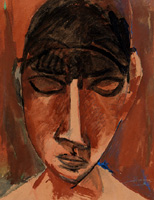 Story 2 continues Story 1 in picturing Stein but adds Alice B. Toklas. Stein was taught how to dress for the camera as well as for the public by her mother. Until she had Alice cut off all her hair, she abided by the rules of her time by keeping her long curly hair pinned up on her head. Alice brought order and style to their homes and provided what was necessary to entertain their visitors. She also helped dress Stein and create her identity. Particularly interesting in this section of the exhibit is a small Picasso painting of Toklas—"Woman with a Fringe" that belongs to a private collector and was shown only at the National Portrait Gallery. Story 2 continues Story 1 in picturing Stein but adds Alice B. Toklas. Stein was taught how to dress for the camera as well as for the public by her mother. Until she had Alice cut off all her hair, she abided by the rules of her time by keeping her long curly hair pinned up on her head. Alice brought order and style to their homes and provided what was necessary to entertain their visitors. She also helped dress Stein and create her identity. Particularly interesting in this section of the exhibit is a small Picasso painting of Toklas—"Woman with a Fringe" that belongs to a private collector and was shown only at the National Portrait Gallery.
Story 3: Art of Friendship
--Picasso
--Photographic Portraits
--The "Second Family" of Artists/Intellectuals
--Other Women of Significance
--Collaborations
Story 3 establishes that the world came to Stein. Stein did not frequent cafés, as is the habit of French people who rarely entertain at home. 27 rue de Fleurus served as a museum of modern art at a time when there was no such institution. 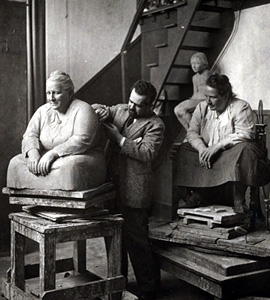 Artists who frequented the Stein "at homes" (before Leo Stein moved out of this apartment) and later the Stein-Toklas teas vied for a place for their work on the wall. However, Gertrude eschewed the work of American artists. Post World War I, brought new alliances (she called men like Christian Bérard, Bernard Faÿ, Bravig Imbs, George Platt Lynes, Virgil Thomson, Pavel Tchelitchew her second family) for Stein and she became more of the sitting saint or Buddha than her former role as advisor. One of the goals of the curators for this exhibit is to make the public more aware of the artists who came after Picasso and Matisse, including Sir Francis Rose, Marsdan Hartley, Pavel Tchelitchew. One of the prized pieces of this story is a silk scarf signed by Francis Rose with all the icons of the Stein era—roses (along with the phrase "rose is a rose is a rose"), poodles with baskets (to commemorate her dog Basket), depictions of her homes. Balancing out the story of the men Stein gathered around her are images of the women who played significant roles. This included vignettes of Dr. Claribel and Etta Cone, the sisters from Baltimore who participated in collecting the art of the Stein salon and who brought a touch of Paris to Baltimore, one of Gertrude's hometowns. Artists who frequented the Stein "at homes" (before Leo Stein moved out of this apartment) and later the Stein-Toklas teas vied for a place for their work on the wall. However, Gertrude eschewed the work of American artists. Post World War I, brought new alliances (she called men like Christian Bérard, Bernard Faÿ, Bravig Imbs, George Platt Lynes, Virgil Thomson, Pavel Tchelitchew her second family) for Stein and she became more of the sitting saint or Buddha than her former role as advisor. One of the goals of the curators for this exhibit is to make the public more aware of the artists who came after Picasso and Matisse, including Sir Francis Rose, Marsdan Hartley, Pavel Tchelitchew. One of the prized pieces of this story is a silk scarf signed by Francis Rose with all the icons of the Stein era—roses (along with the phrase "rose is a rose is a rose"), poodles with baskets (to commemorate her dog Basket), depictions of her homes. Balancing out the story of the men Stein gathered around her are images of the women who played significant roles. This included vignettes of Dr. Claribel and Etta Cone, the sisters from Baltimore who participated in collecting the art of the Stein salon and who brought a touch of Paris to Baltimore, one of Gertrude's hometowns.
Story 4: Celebrity Stein
--The American Lecture Tour
--Stein in World War II
--End of Life: Stein and Toklas
Story 4 puts the largest emphasis on Stein as the writer. Most impressive is a map of the United States that shows Stein's path and stops of her 1934-35 lecture tour. 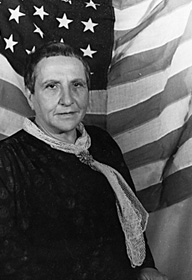 Although Story 3 talks about her opera Four Saints in Three Acts in the category of collaboration, the story of her celebrity is not complete without additional photos of this event as Stein caught up with her opera that had moved to Chicago from its 60 performances in New York City. This section of the exhibit also addresses Stein in World War II and the renewed recognition she got from her book Wars I Have Seen, which was hurried out of France in 1944 as the Americans routed the Germans. What the catalog does is give a more complete story about why Stein and Toklas—Jews, homosexuals, Americans, collectors of what Hitler deemed decadent art—survived WWII. And a footnote in the catalog points to Barbara Will's book, which was not published at the time the Corn-Latimer catalog was written. Although Story 3 talks about her opera Four Saints in Three Acts in the category of collaboration, the story of her celebrity is not complete without additional photos of this event as Stein caught up with her opera that had moved to Chicago from its 60 performances in New York City. This section of the exhibit also addresses Stein in World War II and the renewed recognition she got from her book Wars I Have Seen, which was hurried out of France in 1944 as the Americans routed the Germans. What the catalog does is give a more complete story about why Stein and Toklas—Jews, homosexuals, Americans, collectors of what Hitler deemed decadent art—survived WWII. And a footnote in the catalog points to Barbara Will's book, which was not published at the time the Corn-Latimer catalog was written.
Story 5: Legacies
--The Mother of Us All
--Stein Influence on theater, art, books
--Stein and Popular Culture
--Stein Influence on Queer Culture
Story 5 provides a glimpse of artworks both created by Stein and inspired by Stein. It is a story that is too big to catalog and one can see more of these works inspired by Stein at the Insight & Identity: Contemporary Artists and Gertrude Stein exhibit at the Stanford in Washington Art Gallery. 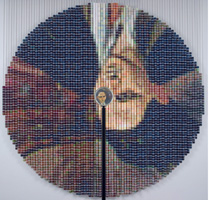 Of particular interest at the Seeing Gertrude Stein exhibition, the Steiny Road Poet notes Devorah Sperber's "After Picasso" collage of an upside down version of Picasso's portrait of Stein. Sperber created this work with spools of thread. The work seems to summarize what Wanda Corn and Tirza Latimer have accomplished with their five stories that includes threads, not only of clothing but also images and stories that have made Gertrude Stein and have also upset the logic of what the public, artistic, and academic worlds see after having come into contact with the genius of Gertrude Stein. Of particular interest at the Seeing Gertrude Stein exhibition, the Steiny Road Poet notes Devorah Sperber's "After Picasso" collage of an upside down version of Picasso's portrait of Stein. Sperber created this work with spools of thread. The work seems to summarize what Wanda Corn and Tirza Latimer have accomplished with their five stories that includes threads, not only of clothing but also images and stories that have made Gertrude Stein and have also upset the logic of what the public, artistic, and academic worlds see after having come into contact with the genius of Gertrude Stein.
STEIN THROUGH THE EYES OF WANDA CORN
A tour through Seeing Gertrude Stein is not complete without reading the fascinating and well-illustrated catalog. The fluidly written book contains information not in the exhibit but which illuminates the entire picture about who Gertrude Stein was, what she accomplished, and what she continues to inspire. It is a page-turner. And contrary to criticism that the exhibition does not adequately address Bernard Faÿ, the man who protected Stein, Toklas, and Stein's art collection during World War II, the catalog provides enough of what was known about Faÿ prior to the September 2011 publication of Barbara Will's book Unlikely Collaboration: Gertrude Stein, Bernard Faÿ, and the Vichy Dilemma to understand why Stein and Toklas survived World War II. The S. R. Poet will write more on the subject of Stein critics in Scene4's Special Issue next month.
The Poet tips her chapeau to Wanda Corn, who has been known to dress up in the fashion of Gertrude Stein with cloche hats, vests and long skirts to 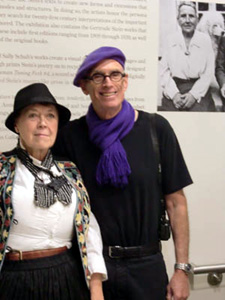 speak lines written by Stein. The Poet tips her hat to Emeritus Professor Corn who still teaches students to read Stein. The Poet tosses on high her beret to the organizer Corn who brought noted Stein scholar Catharine Stimpson to the 2nd annual Feminist Art History Conference to speak about such things as Stein's critics and Stein's activities in WWII and who was there in Paris for the gathering of Steinian literati around the opening of The Steins Collect and all the talks centered on the first Modernist. 2011 has indeed been a special year for really seeing Gertrude Stein and the Steiny Road Poet thanks Dr. Wanda Corn for the big role she played in bringing new light to the human being known as Gertrude Stein. speak lines written by Stein. The Poet tips her hat to Emeritus Professor Corn who still teaches students to read Stein. The Poet tosses on high her beret to the organizer Corn who brought noted Stein scholar Catharine Stimpson to the 2nd annual Feminist Art History Conference to speak about such things as Stein's critics and Stein's activities in WWII and who was there in Paris for the gathering of Steinian literati around the opening of The Steins Collect and all the talks centered on the first Modernist. 2011 has indeed been a special year for really seeing Gertrude Stein and the Steiny Road Poet thanks Dr. Wanda Corn for the big role she played in bringing new light to the human being known as Gertrude Stein.
|


